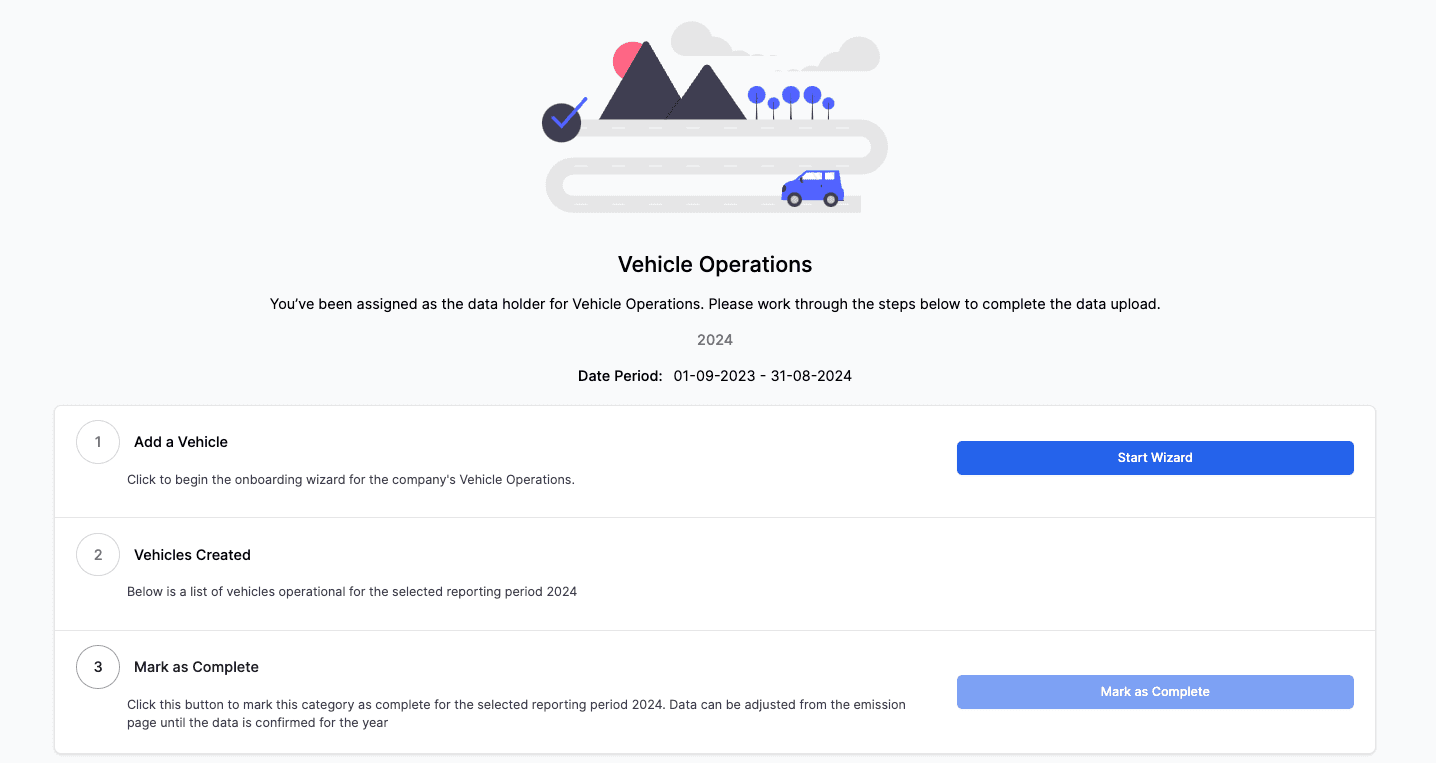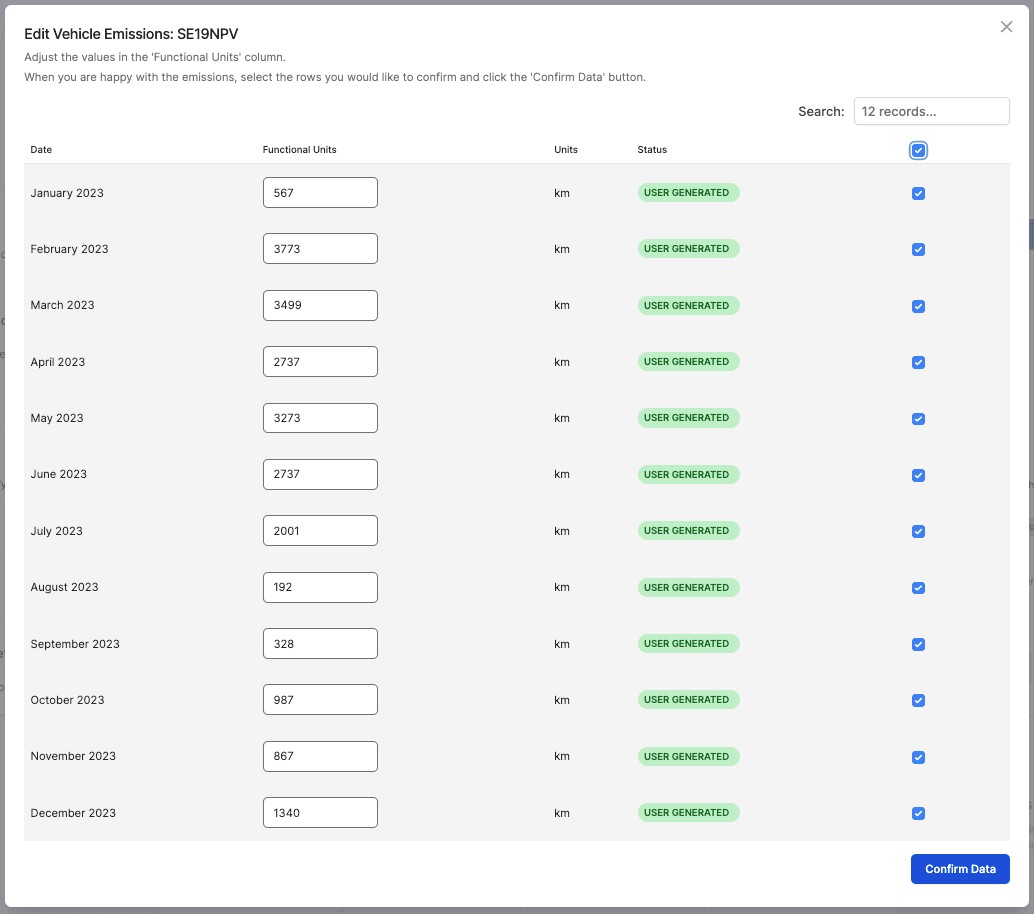By continuing, you agree to our use of cookies.
You’ve been selected as the data holder for Company Vehicles. This means you’re responsible for adding and reviewing data related to any vehicles owned or operated by your company.
If you're in your second year of analysis (or more), you can add more vehicles here, or skip straight to adjusting data where you can adjust the autogenerated data for Reporting Period.
By Company Vehicles and Company Mileage, we are referring to either:
Operational vehicles used for business functions (e.g. delivery vans, service vehicles).
Company-owned vehicles provided to employees for work and/or personal use.
This data contributes to:
Scope 1: Direct emissions from fuel combustion.
Scope 3: Embodied emissions from vehicle manufacturing.
Note: Personal vehicles used for business travel are captured separately under Business Travel (Scope 3). Their embodied emissions are not included.
As most of this information is internal, you shouldn’t need to request data externally.
When you start your task, you’ll see the Vehicle Operations onboarding panel.

Click Start Wizard to begin entering data for a new vehicle.

You’ll be asked to provide the following for each vehicle:
Reg/Identifier: Enter the unique identification code for your vehicle (e.g. MD67 ENG)
Type: This is the type of vehicle with options for Car, Motorcycle or Van
Fuel Type: This is the fuel type of the vehicle with options for Petrol, Diesel, Hybrid, Battery Electric Vehicle (BEV) or Plug-In Hybrid (PHEV). The difference between Hybrid, PHEV, and EV is significant so please ensure these are distinguished.
Size: Indicates the size or dimensions of your vehicle. This is typically defined as follows:
For Cars:
Small: Petrol/LPG/CNG - up to a 1.4-litre engine, Diesel - up to a 1.7-litre engine, Others - vehicles models of a similar size (i.e. market segment A or B)
Medium: Petrol/LPG/CNG - from 1.4-litre to 2.0-litre engine, Diesel - from 1.7-litre to 2.0-litre engine, Others - vehicles models of a similar size (i.e. generally market segment C)
Large: Petrol/LPG/CNG - up to a 1.4-litre engine, Diesel - up to a 1.7-litre engine, Others - vehicles models of a similar size (i.e. market segment A or B)
For Motorcycles:
Small: Mopeds/scooters up to 125cc.
Medium: 125cc to 500cc.
Large: 500cc +.
Make: Input the brand or manufacturer of your vehicle (e.g., Toyota, Ford, BMW).
Model: Specify the specific model or name of your vehicle (e.g., Camry, F-150, 3 Series).
Purchase Date: Enter the date when you acquired the vehicle (select the start of the period if this is unknown).
Retirement Date: Indicate the date when the vehicle is no longer in use or has been retired from service (leave blank if it is currently in use).
Do you have monthly mileage data?
If yes: Enter the kilometers travelled each month. This gives the most accurate calculation of carbon impact and will allow you to analyse why some months had a bigger impact than others.
If no: Enter the total annual mileage (in kilometers). This will then populate the data automatically on a pro-rata basis monthly.
If a vehicle’s Year Data Status is shown as Unconfirmed, you’ll need to verify the distance travelled for each month.

Click Confirm Emissions to open the monthly data modal.

Adjust values in the functional units column if necessary
Check the confirmation box
Click Confirm Data to save your updates (this changes the source from Auto-generated to User-generated)
The vehicle's Year Data Status will now be listed as Confirmed.

You'll see a list of Vehicles that have been created. Once you're satisfied you've added all of them, and have adjusted the data appropriately, you can mark this data as complete.


The section will complete, and you can go back to your to-do list if you have other items to complete, else your work is done!
Your to-do list will now have a completed message in it.

No. This section covers vehicles that are effectively permanent company assets (e.g., lease cars). Temporary hire vehicles are included in the Business Travel category.